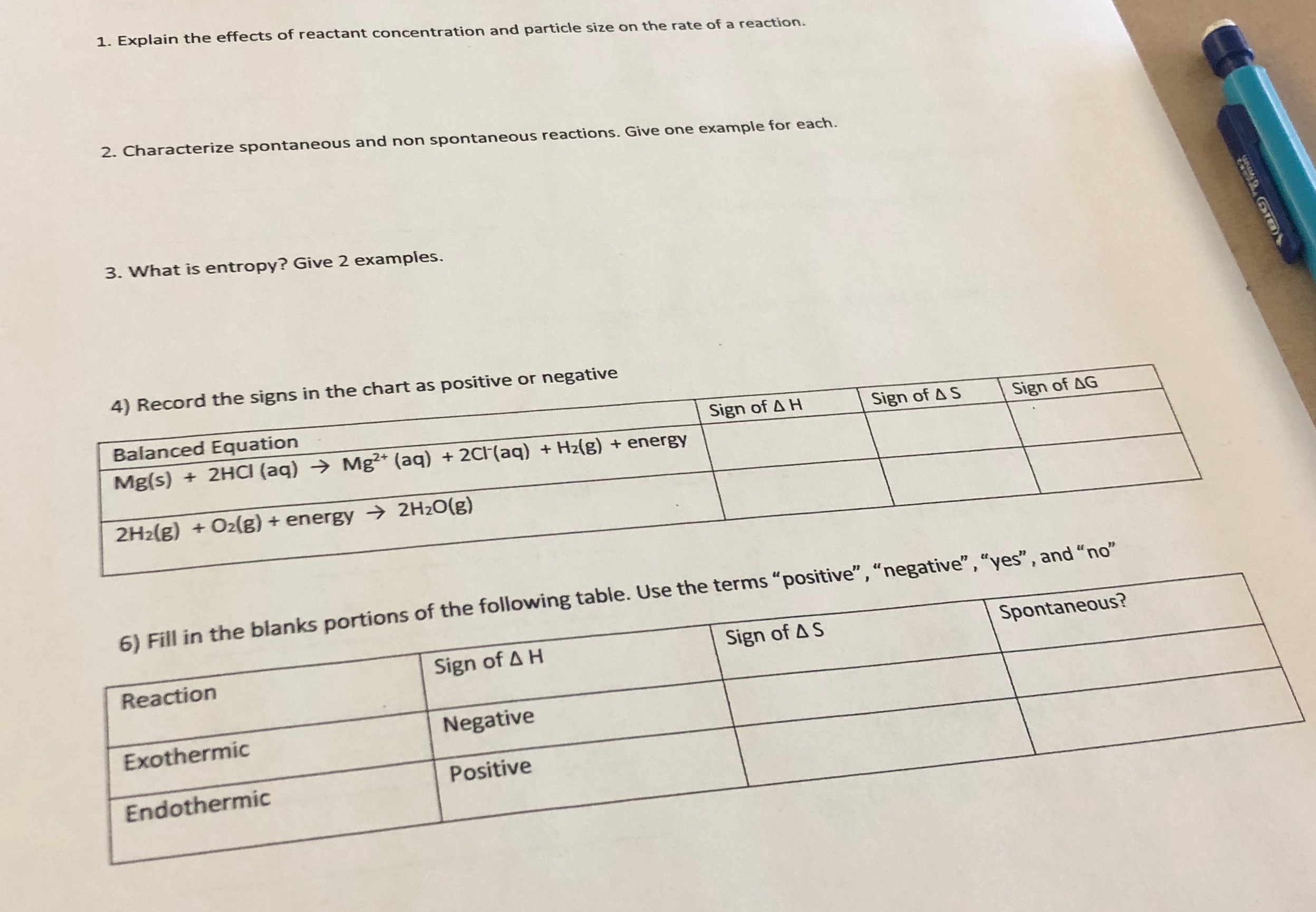Help with entropy/reaction rates homework?

1 Answer
Okay, but you'll have to read through this, and you cannot copy what I say. You'll have to put it into your own words.
Given that a general rate law is
#r(t) = k[A]^m[B]^n# ,higher concentrations lead to higher rates; more collisions occur when there are more particles flying around per unit volume.
Smaller particles travel faster, and thus collide more strongly (at a higher average kinetic energy), making it easier to overcome the activation energy.
A reaction is:
- spontaneous when the change in Gibbs' free energy is negative.
- nonspontaneous when the change in Gibbs' free energy is positive.
Essentially all we want for a spontaneous reaction is that, IF it is fast enough (if the kinetics are observable in a human life span), it will occur.
If it's nonspontaneous, it will never be energetically favorable BUT can be made possible with a catalyst and heat.
- Spontaneous example:
#color(blue)("AgCl"(s) + 2"NH"_3(aq) -> "Ag"("NH"_3)_2^(+)(aq) + "Cl"^(-)(aq))# Aqueous ammonia can be added to silver chloride precipitate to force it to dissolve, because ammonia easily binds to
#"Ag"^(+)# , with a formation constant#K_f# larger than#10^7# .
- Nonspontaneous example:
#color(blue)(6"CO"_2(g) + 6"H"_2"O"(l) -> "C"_6"H"_12"O"_6(s) + 6"O"_2(g))# Photosynthesis is known to be nonspontaneous. It doesn't occur at night but it occurs in the day. What is the catalyst?
Entropy is the amount of energy dispersal at a certain temperature. The more motion a system has, the more entropy it has.
I assume by "examples" it means where entropy is important or where entropy is demonstrated.
Examples
- Mixing
#"NaCl"# into water is accompanied by a positive entropy change that is the driving factor for the process.
#color(blue)("NaCl"(s) stackrel("H"_2"O"(l)" ")(->) "Na"^(+)(aq) + "Cl"^(-)(aq))# The enthalpy of solution
#DeltaH_(sol n)# is around#"3.9 kJ/mol"# , so it requires a large enough, positive entropy of solution#DeltaS_(sol n)# to overcome the positive enthalpy, which it has.
- Freezing of water into ice decreases the entropy of the water.
#color(blue)("H"_2"O"(l) stackrel("freeze ")(->) "H"_2"O"(s))# By freezing water, you release kinetic energy (in the form of heat) that was present from the rotation of water molecules and form more ordered hydrogen-bonding interactions.
Through the release of energy, motion decreases, forming a more rigid structure in ice. Entropy thus has decreased.
#ul("Balanced Eqn.")#
#"Mg"(s) + 2"HCl"(aq) -> "Mg"^(2+)(aq) + 2"Cl"^(-)(aq) + "H"_2(g) + "energy"# Notice how energy is "on the products' side". That implies it is released, which is exothermic, meaning
#DeltaH < 0# . A gas is produced, from a solid plus a liquid, increasing entropy and thus making#DeltaS > 0# .We know that
#DeltaG = DeltaH - TDeltaS# , so
#color(green)(DeltaG) = (-) - (+)(+) = color(green)((-)" always")#
#color(blue)(ul(DeltaH" "" "" "DeltaS" "" "" "DeltaG))#
#color(blue)((-)" "" "(+)" "" "" "(-))#
#ul("Balanced Eqn.")#
#2"H"_2(g) + "O"_2(g) + "energy" -> 2"H"_2"O"(g)# Energy is "on the reactants' side", so the process absorbs energy (is endothermic). Thus,
#DeltaH > 0# .We had three mols of gas, and ended up with two. Less gas = less motion = less entropy, so
#DeltaS < 0# .We know that
#DeltaG = DeltaH - TDeltaS# , so
#color(green)(DeltaG) = (+) - (+)(-) = color(green)((+)" always")#
#color(blue)(ul(DeltaH" "" "" "DeltaS" "" "" "DeltaG))#
#color(blue)((+)" "" "(-)" "" "" "(+))#
This is evidently made to reflect what you saw in question 4. Just regurgitate (and analyze...).
#ul("Reaction"" "" "" "DeltaH" "" "" "DeltaS" "" "" ""Spontaneous?")#
#"Exothermic"" "" ""Negative"" ""Positive"" ""Yes of course"#
#"Endothermic"" "color(white)(/)"Positive"" ""Negative"" ""No sirree"# [As we said before,
#DeltaG < 0# means spontaneous. Read#(2)# .]

